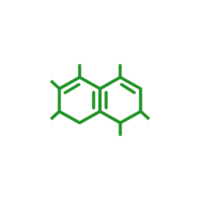NanoSlic Ceramic Coating Technology
Chemistry
Based on a revolutionary ceramic platform chemistry, NanoSlic presents a new approach to protective nanocoatings. Recent advances in polymer science, surface chemistry and nanotechnology have led to state-of-the-art coating solutions. Other chemistries, such as self-assembling monolayers (SAMs) and sol-gel chemistry, provide only a limited and temporary surface modification when exposed to real-world conditions.
NanoSlic’s unique hybrid structure works in 3 ways:

It forms a dense network of strong chemical bonds to the substrate

It forms an inert, high-performance binder polymer layer

It develops a highly hydrophobic and oleophobic contact surface
NanoSlic is the top choice for surface protection
How Nanoslic Works
NanoSlic is largely composed of silica, structured with silica bonds. As such, NanoSlic materials are inherently capable of maintaining properties at temperatures well beyond non-ceramic polymers.
NanoSlic coatings are resistant to most solvents and will be unaffected by a wide range in pH.
Because 9H hardness is achieved in most NanoSlic formulations, scratch resistance is improved. By incorporating specific functional groups to the polymer, various properties can be achieved including ambient temperature curing, heat-induced crosslinking and other physical properties.
Interesting and useful surface effects can be achieved such as NanoSlic’s characteristic hydrophobicity and oleophobicity.
Low surface energy and ceramic structure make NanoSlic a unique nanocoating. NanoSlic is a revolutionary coating technology that offers many of the benefits of “advanced ceramics” but does not require a high cost, multi-step process that includes “firing.”
NanoSlic can be applied to a wide variety of surfaces. The required thickness of the coating will depend on the application and the desired result.
Generally, the coating thickness with 1 – 4 microns (µ.) NanoSlic protects and enhances surfaces of metals, glass, ceramics, polymers and coatings and many plastics.
It is scratch resistant and creates a surface that is easy to clean. Curing takes place at room temperature or can be accelerated with heat.
Applications include:
- Automotive Surfaces
- Appliances
- Medical
- Electronics
- Telecommunications
- Marine
- Industrial Applications
Outstanding Properties:
- Contact Angle: 107°/water and 64°/n-hexadecane
- Sliding Angle: 9.1o /water 1.4o /IPA (NS110)
- Temperature Resistance: 350° F Continuous/450° F Intermittent
- Pencil Hardness: 9H
Products:
Hydrophobic and Oleophobic Coating
Phobia is greek for “fear” and Hydro for “water.” Hydrophobic surfaces repel water. Oleophobic surfaces repel oil.
NanoSlic is a permanent hydrophobic and oleophobic coating that repels water, water-based fluids, oils, and other chemicals. This makes it an ideal permanent coating to protect many industrial and consumer surfaces. Its products are in use in a wide variety of applications including:
NanoSlic’s oleophobic and hydrophobic properties provide one key benefit:
Easy to Clean
Surfaces that repel water and oils are much easier to clean. Products that are usually hard to remove come right off due to Nanoslic’s Hydrophobic and Oleophobic properties. As an example, see how Nanoslic can be used to prevent graffiti.
The easy-to-clean property is also incorporated into our line-up of advanced ceramic coatings for cars, trucks and RVs.
About NanoSlic
NanoSlic is the world’s most advanced ceramic coating technology. Application driven formulations provide protection while also providing a high-tech, high-performance aesthetic.
